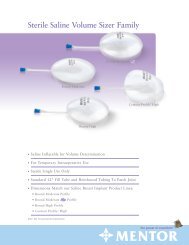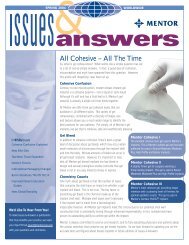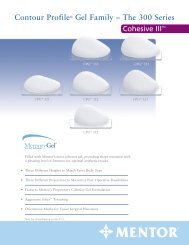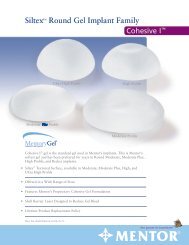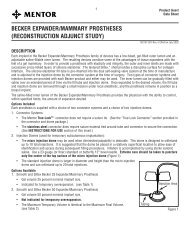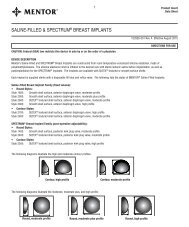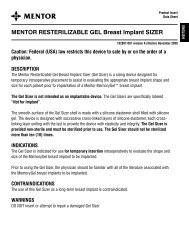Breast Reconstruction Patients Educational Brochure - Mentor
Breast Reconstruction Patients Educational Brochure - Mentor
Breast Reconstruction Patients Educational Brochure - Mentor
- No tags were found...
You also want an ePaper? Increase the reach of your titles
YUMPU automatically turns print PDFs into web optimized ePapers that Google loves.
15WARNING – The following is a list of possible complications associated with breast implantsurgery. Make sure you read and understand these before deciding whether to have breastimplant surgery. Please refer to the following sections in this brochure for more detail onthese factors: Section 4 - RISKS ASSOCIATED WITH BREAST IMPLANTS, Section 7 - CARINGFOR YOURSELF AFTER BREAST IMPLANT SURGERY and Section 8 - MENTOR’S CLINICALSTUDY RESULTS.• <strong>Breast</strong> implants are not expected to last for the rest of your life, and breastimplantation may not be a one-time surgery. It is likely that you will need othersurgery related to your breast implants over the course of your life. These additionalsurgeries can include implant removal with or without replacement, or they caninclude other surgical procedures.• Many of the changes to your breast that may occur as a result of breast implantsurgery will be permanent and cannot be undone. If you have your implants removed,your skin may be permanently dimpled, puckered, or wrinkled.• <strong>Breast</strong> implants may interfere with your ability to produce milk (lactate) for breastfeeding. If you are planning to breast feed your infant, be prepared to use formula andbottle-feed your baby in the event you have difficulty breast feeding.• Mammograms of a reconstructed breast are not usually performed.The following may apply to the contralateral breast:‣ ¾ Mammography for detecting breast cancer (or cancer recurrence) may be moredifficult with breast implants in place. You will need more views captured thanduring a routine mammogram. Therefore, the procedure will take more time andyou will be exposed to more radiation than during a standard routine screeningmammogram. However, the benefits of mammograms outweigh this risk. Youmust tell the technologist that you have silicone gel breast implants before theprocedure. The technologist can then use special techniques to get the bestpossible views of your breast tissue.• Your implants could rupture without you feeling the rupture or noticing any changein your breasts. In some of these instances even your doctor might not be able totell that a rupture has occurred. A rupture that has no symptoms is called a “silent”rupture. The best way to diagnose a silent rupture is with an MRI examination. AnMRI is similar to using x-ray imaging but an MRI machine uses magnetism and notx-ray radiation. Because silent ruptures can occur and because they are difficult todetect, you should have an MRI 3 years after your breast implant surgery and thenevery 2 years after that for as long as you have your breast implants.• Routine self-examination of your breasts may be more difficult with implants.However, you should still perform an examination of your breasts every month forcancer screening. Ask your surgeon to help you distinguish the implant from yourbreast tissue. You should perform an examination of your breasts for the presenceof lumps, swelling, hardening, or change in implant shape, which may be signs ofrupture of the implant. Report any of these symptoms or persistent pain to yourdoctor. Your surgeon may recommend an evaluation via MRI to check for rupture.• In general, private insurance that covers medically necessary mastectomies will alsocover breast reconstructive surgery. Insurance coverage for reoperation proceduresor additional surgeon’s visits following reconstruction may not be covered, dependingon the policy. Because health insurance policies vary and can change over time,no general guidance can be provided regarding coverage under any particularhealth insurance plan. Be sure to check with your insurance company to obtainspecific information about the extent of your health coverage before having breastreconstruction with implants.• Capsular contracture is not to be treated by closed capsulotomy or forceful externalcompression, which will likely result in implant damage, rupture, folds, and/or hematoma.





